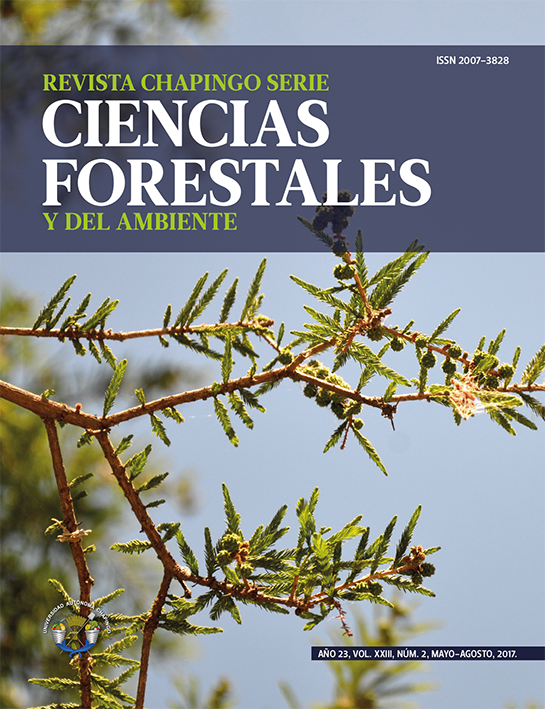Abstract
Aim: In this study, significant differences were evaluated in additive equation systems for estimating the total volume of individual trees in nine species of the genus Pinus (P. cooperi, P. durangensis, P. arizonica, P. leiophylla, P. teocote, P. engelmannii, P. lumholtzii, P. strobiformisand P. herrerae), and three of the genus Quercus (Q. sideroxyla, Q. durifoliaand Q. rugosa), and among regional forest management units (UMAFOR) when dealing with the same species. Materials and Methods: To evaluate whether equation systems are different among tree species of the same genus and among the UMAFORs for the same species, two complementary statistical analyzes were used based on the fitting of a reduced and a full equation system: the F test of nonlinear extra sum of squares method, and the parameter significance analysis. The reduced equation system does not differentiate among species or UMAFOR, while the full equation system corresponds to a set of species-specific or UMAFOR-specific parameters. Results and Discussion: The results of the study indicate that, for most species studied, systems of equations are significantly different. It is also reported the need to use regional models in 10 of the 12 tree species, except for P. strobiformis and Q. rugosa.References
Aguilera, R. M. (2001). Pinus ayacahuite Ehren, paquete tecnológico. México: CONAFOR.
Barrio-Anta, M., Balboa, M., Castedo, D. F., Diéguez-Aranda, U., & Álvarez-González, J. G. (2006). An ecoregional model for estimating volume, biomass and carbon pools in maritime pine stands in Galicia (northwestern Spain). Forest Ecology and Management, 223, 24‒34. doi: https://doi.org/10.1016/j.foreco.2005.10.073
Bates, D. M., & Watts, D. G. (1988). Nonlinear regression analysis and its applications. New York, USA: Wiley.
Calama, R., Cañadas, N., & Montero, G. (2003). Inter-regional variability in site index models for even-aged stands of stone pine (Pinus pinea L.) in Spain. Annals of Forest Science, 60, 259–269.doi: https://doi.org/10.1051/forest:2003017
Castedo, F., Barrio, M., Parresol, B. R., & Álvarez-González, J. G. (2005). A stochastic height-diameter model for maritime pine ecoregions in Galicia (north-western Spain). Annals of Forest Science, 62, 455–465.doi: https://doi.org/10.1051/forest:2005042
Corral-Rivas, J. J., Álvarez-González, J. G., Ruíz-González, A. D., & Gadow, Kv. (2004). Compatible height and site index models for five pine species in El Salto Durango (Mexico). Forest Ecology and Management, 201, 145–160.doi: https://doi.org/10.1016/j.foreco.2004.05.060
Corral-Rivas, J. J., Barrio-Anta, M., Aguirre-Calderón, O. A., & Diéguez-Aranda, U. (2007a). Use of stump diameter to estimate diameter at breast height and tree volume for major pines species in El Salto, Durango (Mexico). Forestry, 80, 29‒40.doi: https://doi.org/10.1093/forestry/cpl048
Corral-Rivas, J. J., Diéguez-Aranda, U., Castedo, F., & Corral-Rivas, S. (2007b). A merchantable volume system for major pine species in El Salto, Durango (Mexico). Forest Ecology and Management, 238, 118‒129.doi: https://doi.org/10.1016/j.foreco.2006.09.074
Corral-Rivas, S., Álvarez-González J. G., Crecente-Campo, F., & Corral-Rivas, J.J. (2014). Local and generalized height-diameter models with random parameters for mixed, uneven-aged forests in Northwestern Durango, Mexico. Forest Ecosystems, 1(6).doi: https://doi.org/10.1186/2197-5620-1-6
Corral-Rivas, S., Álvarez-González, J. G., Corral-Rivas, J. J., & López-Sánchez, C. A. (2015). Characterization of diameter structures of natural forests of northwest of Durango, Mexico. Revista Chapingo Serie Ciencias Forestales y del Ambiente, 21(2), 221–236.doi: https://doi.org/10.5154/r.rchscfa.2014.046
Corral, R. S., Návar, J. J., & Fernández, S. F. (1999). Ajuste de funciones de ahusamiento a los perfiles fustales de cinco Pináceas de la región de El Salto, Durango. Madera y Bosques, 5, 53‒65. http://www.redalyc.org/pdf/617/61750205.pdf
Cunia, T. (1964). Weighted least squares methods and construction of volume tables. Forest Science, 10, 180‒191.
Cámara de Diputados del H. Congreso de la Unión. (2003). Ley de desarrollo forestal sustentable. México: Diario Oficial de la Federación. http://www.diputados.gob.mx/LeyesBiblio/pdf/259_100516.pdf
Diéguez, A. U., Barrio, A. M., Castedo, D. F., Ruíz, G. A. D., Álvarez, T. M. F., Álvarez, G. J. G., & Rojo, A. (2003). Dendrometría. Madrid, España: Fundación Conde del Valle de Salazar-Ediciones Mundi-Prensa.
González, M. S., González, M., & Márquez, M. A. (2007). Vegetación y ecorregiones de Durango. México: Plaza y Valdés Editores-Instituto Politécnico Nacional.
Harvey, A. C. (1976). Estimating regression models whit multiplicative heteroscedastiticity. Econometrica, 44, 461‒465.doi: https://doi.org/10.2307/1913974
Huang, S., Price, D., & Titus, S. J. (2000). Development of ecoregion-based height-diameter models for white spruce in boreal forests. Forest Ecology and Management, 129, 125–141.doi: https://doi.org/10.1016/S0378-1127(99)00151-6
Larson, P. R. (1963). Stem form development of forest trees. USA: Society of American Foresters.
López-Serrano, P., López Sánchez, C. A., Solís-Moreno, R., & Corral-Rivas, J. J. (2016). Geospatial estimation of above ground forest biomass in the Sierra Madre Occidental in the State of Durango, Mexico. Forests, 7(70), 1‒13.doi: https://doi.org/10.3390/f7030070
Martínez-Antúnez, P., Wehenkel, C., Hernández-Díaz, J. C., González-Elizondo, M., Corral-Rivas, J. J., & Pinedo-Álvarez, A. (2013).Effect of climate and physiography on the density of tree and shrub species in Northwest Mexico. Polish Journal Ecology, 61(2), 283–295. https://www.researchgate.net/publication/249963406_Effect_of_climate_and_physiography_on_the_density_of_tree_and_shrub_species_in_Northwest_Mexico
Parresol, B. R. (1999). Assessing tree and stand biomass: A review whit examples and critical comparisons. Forest Science, 45, 573‒593.http://www.sidalc.net/repdoc/A11144i/A11144i.pdf
Quiñonez-Barraza, G., De los Santos-Posadas, H. M., Álvarez-González, J. G., & Velázquez-Martínez, A. (2014). Sistema compatible de ahusamiento y volumen comercial para las principales especies de Pinus en Durango, México. Agrociencia, 48, 553‒567. http://www.scielo.org.mx/pdf/agro/v48n5/v48n5a8.pdf
Schilaegel, B. E. (1982). Acer negundo biomasas componet regression analysis for the Mississipi Delta. Forest Science, 28, 355‒358.
Schumacher, F. X., & Hall, F. D. S. (1933). Logarihmic expression of timber-tree volume. Journal of Agricultural Research, 47(9), 719‒734.https://naldc.nal.usda.gov/download/IND43968352/PDF
Statistical Analysis System Institute Inc. (SAS). (2008). SAS/ETS® 9.2. User’s guide. Cary, NC, USA: Author.

This work is licensed under a Creative Commons Attribution-NonCommercial 4.0 International License.
Copyright (c) 2017 Revista Chapingo Serie Ciencias Forestales y del Ambiente



